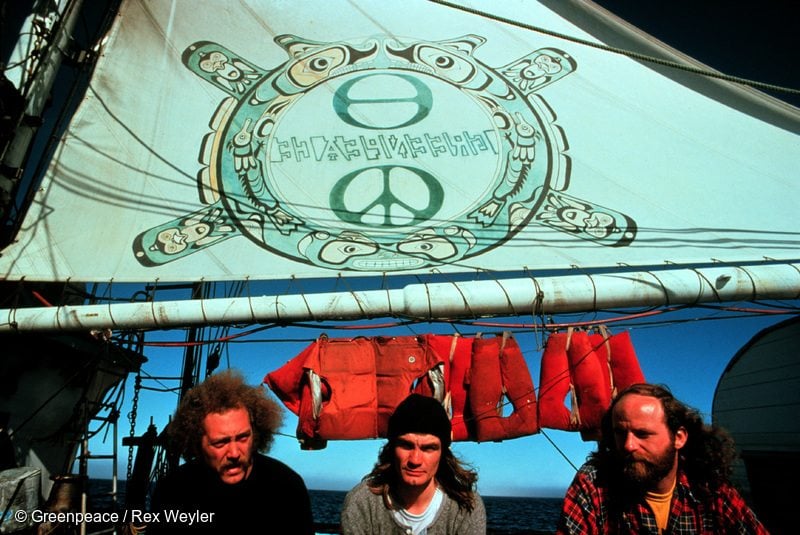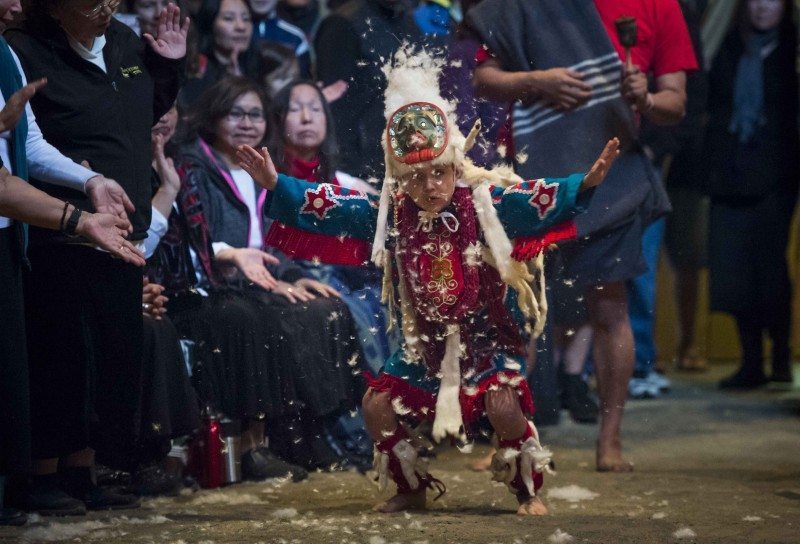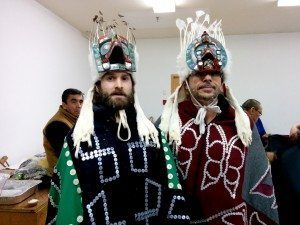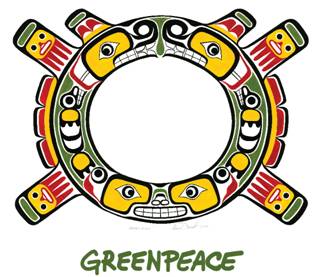Editor’s note: read an expanded version of this history here.
A few months ago I had the privilege to watch an advance screening of the extraordinary documentary “How to Change the World.” Jerry Rothwell’s compelling film brings to life a formative chapter of Greenpeace’s early history, seen through the eyes of late co-founder Bob Hunter.
The film is rich with passionate people who founded this intrepid organization and I felt a sense of pride to work for an organization that has an incredible legacy left by such a small but powerful group of individuals.
There was, however, one image present throughout the film that brought both a knowing smile and a slight wince to my face, that of the old Greenpeace ecology and peace symbol encircled by a double-headed serpent.
What we actually see in the film — most notably on the sails of Greenpeace’s first ship, the Phyllis Cormack — is an altered version of an ancient crest called the Sisiutl, sacred to a number of indigenous peoples of the Pacific Northwest.
How this symbol came to be part of Greenpeace’s identity is both an important part of our origins and a troubling story of cultural appropriation. That’s why my job for the past year has been managing the Sisiutl Renewal Project, which has the goal of both restoring the dignity of the crest at Greenpeace and reconciling it with the spirit with which it was shared with us.
To understand this quest for reconciliation, we have to go back to the beginning.
Greenpeace’s First Mission
In 1971, Greenpeace embarked on its first mission: protesting U.S. nuclear testing at Amchitka, Alaska.
A dozen activists set sail in a chartered boat, stopping along the way at the indigenous community of ‘Yalis, or Alert Bay, on Canada’s west coast. Here, members of the Kwakwaka’wakw group of First Nations gifted the crew with wild coho salmon and a blessing for their journey.
Though they were eventually turned away by the U.S. Coast Guard before confronting the nuclear weapons test, the crew was invited to a celebration in their honor back at the Big House in Alert Bay. There they were acknowledged by members of various Kwakwaka’wakw communities for their courage in standing up to the Unites States military industrial complex. The Kwakwaka’wakw honored the crew with a feast and with traditional regalia, and invited them to participate in one of their ceremonial dances, the Peace Dance.
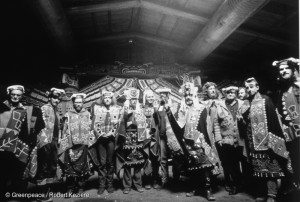
Greenpeace voyagers in full regalia at Alert Bay following the first Greenpeace voyage to Amchitka. Photo by Greenpeace / Rex Wyler.
Shortly after that ceremony, Bob Hunter was given a blue cloth with a Sisiutl crest by a leader of one of the Kwakwaka’wakw communities.
The Sisiutl Symbol and Greenpeace
The Sisiutl symbol is a powerful spiritual crest which for the Kwakwaka’wakw symbolizes the balance of life between good and evil. Wearing it and telling its stories helps warriors and healers with their work. It is also used to protect canoes and Big Houses.
Only certain Kwakwaka’wakw individuals and families, as well as other coastal First Nations, have the cultural and spiritual rights to display the Sisiutl in ceremonies, so for the Kwakwaka’wakw to share this crest with Bob and Greenpeace was a huge honor.
We don’t actually know at this point what the original Sisiutl on that piece of cloth looked like or why it was shared with Bob. We can only surmise that, given its meanings of protection and general association with the sea and warriors, it was a blessing or gift.
What we do know is that its form was dramatically altered sometime between 1974 and 1975, when Bob and his team decided to use it as the basis for a new symbol for their anti-commercial whaling campaign.
In making that decision to adopt and adapt the Sisiutl, the sacred crest was in fact inappropriately altered and hybridized, its meaning forever changed. With the benefit of hindsight, and with greater understanding today of Kwakwaka’wakw customs and traditions, we recognize that we as Greenpeace didn’t have the right to alter it and make it our own — especially to the degree that this hybrid continues to be displayed.
Restoring the Sisiutl Symbol
With this in mind, Greenpeace approached representatives of Kwakwaka’wakw communities in 2012 to inquire about how to restore the Sisiutl to a more culturally appropriate form and to explore the possibility of having it re-dedicated by representatives of these First Nations. It was suggested we contact well-known Kwakwaka’wakw artist and cultural leader Beau Dick to help us. Beau agreed to redesign the Sisiutl crest for our use in perpetuity, and we in turn agreed never to change the design.
In March of this year, we returned to Alert Bay, where we had the privilege of renewing and re-dedicating the Sisiutl crest at a community feast ceremony hosted by a prominent family. A few of the community members present that day had been at the 1971 ceremony as children.
There, Greenpeace representatives — together with surviving members of the original crew of the Phyllis Cormack — addressed the many hereditary chiefs and community members and apologized for the misappropriation of the original Sisiutl symbol. Beau’s redesign of the Sisiutl was then unveiled.
Later that night, myself and colleague Mark Worthing were asked to perform the Peace Dance in full regalia (shown left). That moment, echoing that historic day in the fall of 1971, helped reinvigorate the direct and emotional ties between our Greenpeace community and the Kwakwaka’wakw.
Months later aboard the Esperanza we introduced the new Sisiutl crest to the current fleet of Greenpeace ships through a special blessing ceremony with representatives from the Kwakwaka’wakw communities. The new Sisiutl crest flies proudly as a flag next to the international Greenpeace flag on board the Esperanza.
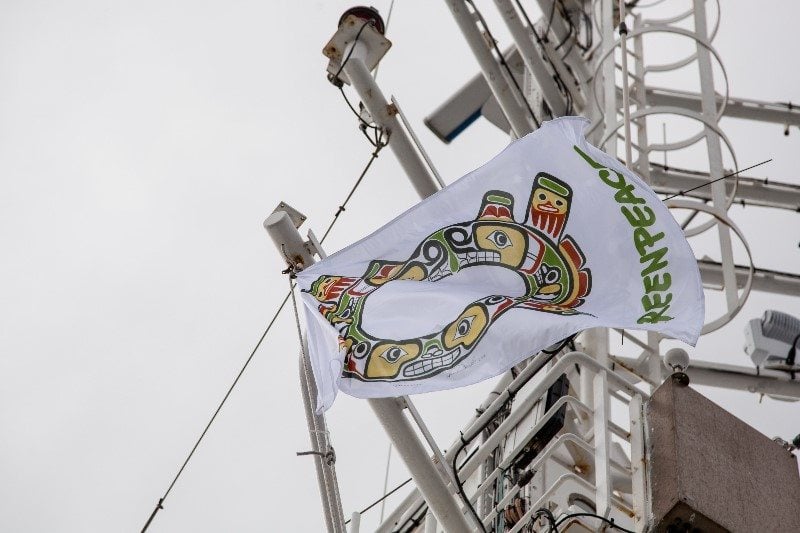
The renewed Sisiutl Crest flies proudly alongside international Greenpeace and Haida Nation flags on the Esperanza ship. © Joseph Strohan / Greenpeace.
Rewriting Our Story
“How to Change the World” shows the power of impassioned individuals to make a difference just as much as it reveals the type of human frailties that led us to appropriate the Sisiutl symbol.
We acknowledge the heroics of the people Greenpeace is built on. In the case of the Sisiutl, we must also take responsibility for the legacy of its misuse. Aside from following proper protocols and undertaking ceremonies that authorize us to carry the new Sisiutl, we are now rewriting the story of how we came to the symbol and what it actually means, and will circulate it — along with prints of the new Sisiutl — to Greenpeace offices around the world.
